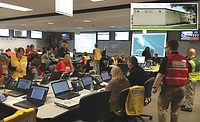Building a Better Campaign for School Security


Michele Gay is the co-founder of Safe and Sound: A Sandy Hook Initiative. Photo courtesy of Michele Gay


It’s about time that our nation begins to focus more solidly on the security and safety of our schools. We’ve enjoyed a relatively safe existence in our schools for decades and decades. We have had some very high-profile tragedies in our schools recently, from weather to shooters to fires, but for the most part, our schools remain the safest place to be for our kids. But they are not forever going to be that way. It's time for our nation to address school safety in a more proactive way. We are noticing trends and events that are preventable in this day and age.”
Michele Gay is taking up the banner for K-12 school security, and the fight is personal. Gay, a former public school educator who lost her daughter Josephine to the Sandy Hook school shooting in 2012, joined forces with Alissa Parker, the mother of Josephine’s good friend Emilie, who was also killed in the shooting. Through their discussions with friends, neighbors and first responders in the Sandy Hook community, they co-founded Safe and Sound: A Sandy Hook Initiative.
“The conversations all had this common thread: ‘How come we’re still in this position? How come we’re not learning significant lessons from each of these tragedies that are happening in our schools and communities, whether they be shootings, other acts of violence, a weather-related incident? We just don’t seem to be making significant progress, and the stories just keep repeating on the news,’” Gay says.
Safe and Sound started its grassroots movement by investigating which campaigns for change in schools have been successful in the past. Not many had the impact, and the staying power, of fire safety.
“In schools and public buildings, our fire safety standards and practices are top-notch, they’re always evolving and improving, and as a result, in our schools, we haven’t had a death in a fire in more than 56 years,” she says.
As a result, Safe and Sound modeled their campaign around three steps: education, preparation and training, and innovation. “These, we feel, will be the pillars of a meaningful school safety campaign, as they have been for our national fire safety campaign.”
SafeandSoundSchools.org, the organization's website,has free resources available for parents, students, teachers and staff, as well as school security personnel and first responders. These are resources developed by the organization, as well as those gathered from other security experts, law enforcement studies and more. In addition, members of the organization, Gay included, are traveling the country to give speeches and training to community groups, schools, first responders and more. What’s important, she says, is to develop language and vocabulary that all groups can understand and discuss in the same meeting – common sense language, without lingo, gets the best results from all parties, she adds.
But common sense language doesn’t necessarily mean common recommendations: “We live in a very diverse country of school communities,” she says. “What makes sense for one district might not work for a district just a few miles down the road. One might need security officers or police, and a more rural school might not. So we provide a general framework: The Straight ‘A’ Safety model. It approaches school safety as a continuum, not a single set goal. The three ‘A’s are: Assess, Act and Audit. Through these steps, communities can work to improve any aspect of school safety, from bullying, to cyber-safety, to security. All of our free support materials are designed around this process.”
This is something even parents can do as they walk through a school to pick up their child, she says – assess if the doors lock, if there are working cameras, if IDs get checked at the door. More officially, the Department of Homeland Security and other local agencies offer safety and security assessments to schools. Then schools can translate that assessment into plans and priorities, and after implementation, they can perform drills, get feedback and reassess.
“This is a very active process,” Gay says. “And it helps develop the culture, the mindset of safety in schools.”
While school safety teams and local first responders might be the first stakeholders to come to mind, parents and students are taking these recommendations and encouraging more investment in school security as well.
A parents’ group in Massachusetts organized a speaking event with Safe and Sound for the PTA, which evolved into a community night with first responders, community leaders and parents. This kick-started the formation of a district-level school security and safety team with a wide base of members and stakeholders.
A group of students at an Oklahoma high school decided to start an awareness campaign through a video project in the cafeteria. The organizers asked students “What types of things could happen here?” The students’ answers were varied: “Your boyfriend could break up with you.” “You could fail a test.” “There could be a fire.” “There could be a shooting.” This video was shared with the school board and other community leaders, and it earned students seats at the table with the school safety team, Gay adds. “The simple act of starting a conversation is powerful.”
Safe and Sound was also asked to contribute to PASS, the Partner Alliance for Safer Schools, an initiative from SIA and NSCA (National Systems Contractors Association) to create standards for K-12 school security. Similar to Safe and Sound, PASS wanted to echo fire code campaigns with vendor agnostic advice and standards for school security, training and technology. Michele Gay unveiled the first set of PASS standards at ISC West in April 2015.
“The growth (of Safe and Sound) has been faster than we anticipated,” says Gay. “Our cause, safety, is not the most glamorous cause, but people are ready, and people are eager to learn about the very practical things everyone can do to make schools safer. We’re already outgrowing our website and now hiring a staff to keep up with the work – things we had no idea we would be doing when we founded this organization.”
Want to help Safe and Sound: A Sandy Hook Initiative continue to grow? Visit www.SafeandSoundSchools.org/Support to learn how.
Looking for a reprint of this article?
From high-res PDFs to custom plaques, order your copy today!







